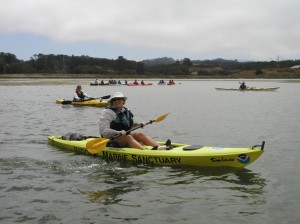
Dr. Gary Griggs, Professor of Earth & Planetary Sciences and Director of the Institute of Marine Sciences and Long Marine Laboratory at UC Santa Cruz, provides perspective on the economic value of California’s coastal ocean and how marine scientists are a significant part of the equation.
While its difficult to put a dollar value on many things, economists are pretty adept at figuring out ways to measure things in economic terms. A recent effort, the National Ocean Economic Project, has determined that California has the nation’s largest ocean economy. Not only would our state’s economy rank 8th in the world (at $1.8 trillion, between Brazil and Italy) if it were a country, but we have an annual ocean economy totaling about $46 billion in California in 2005. For comparison, agriculture produces about a $37 billion annually and it generates an additional $100 billion in related economic activity. I won’t try to explain where that number comes from, however.
In order to keep track of the something as complex and large as ocean business in some understandable way, the state’s ocean economy was divided into six major components:
- Construction-all marine related construction
- Living resources-fishing, seafood markets and processing, and aquaculture
- Minerals-sand and gravel extraction; oil and gas exploration and production
- Ship and boat building and repair
- Tourism and recreation-amusement and recreation; eating, drinking and lodging; marinas, RV parks and camping; sporting good; zoos and aquaria
- Transportation- Deep-sea freight transport, marine transportation and services, search and navigation equipment, and warehousing.
Tourism, recreation and transportation made up about 93% of California’s total ocean economy in 2005, the last year the data were collected. Living marine resources, all of those fishing related jobs and income, constitute only about 2.5 percent of the total. Even more surprising, the mineral and energy sectors, mostly southern California offshore oil and gas, made up less than 1% of our total ocean economy. This would be a totally different percentage for the Gulf Coast states with over 4000 oil drilling and production platforms operating in the Gulf of Mexico. A major difference is that over the long haul, oil and gas are nonrenewable and some day will be gone. Tourism and recreation, key elements of California’s coastal ocean economy, can be sustained forever.
An increasingly important component of our Monterey Bay region is marine research and education. There are presently about 23 individual ocean institutions, agencies or programs located between Santa Cruz and Pacific Grove, with three hubs or centers: Santa Cruz, Moss Landing, and the Monterey Peninsula. These range from research institutions like the Institute of Marine Sciences and Long Marine Laboratory at UCSC, Moss Landing Marine Laboratories, the Monterey Bay Aquarium Research Institute, the Naval Postgraduate School and Hopkins Marine Station; state and federal ocean agency offices and laboratories such as the United States Geological Survey, the National Marine Fisheries Service, the Monterey Bay National Marine Sanctuary, Fleet Numerical Meteorology and Oceanography Center and the Naval Research Laboratory, to name a few. We also have public education facilities like the Monterey Bay Aquarium and the Seymour Marine Discovery Center.
These institutions employ about 2200 scientists and support staff and have a total annual budget of about $265 million. Funding comes from a combination of federal agencies, state agencies, foundations, industry and the public. Over the past two decades the Monterey Bay region has become recognized as a national and international center for ocean research and education, which continues to attract additional programs and scientists to the area. We have an exceptional coastal ocean environment for research and education, from Monterey Submarine Canyon to a biologically rich and productive coastal zone, which have attracted one of the largest and most diverse group of marine scientists in the world.
This article was published in the Santa Cruz Sentinel on October 23, 2010.